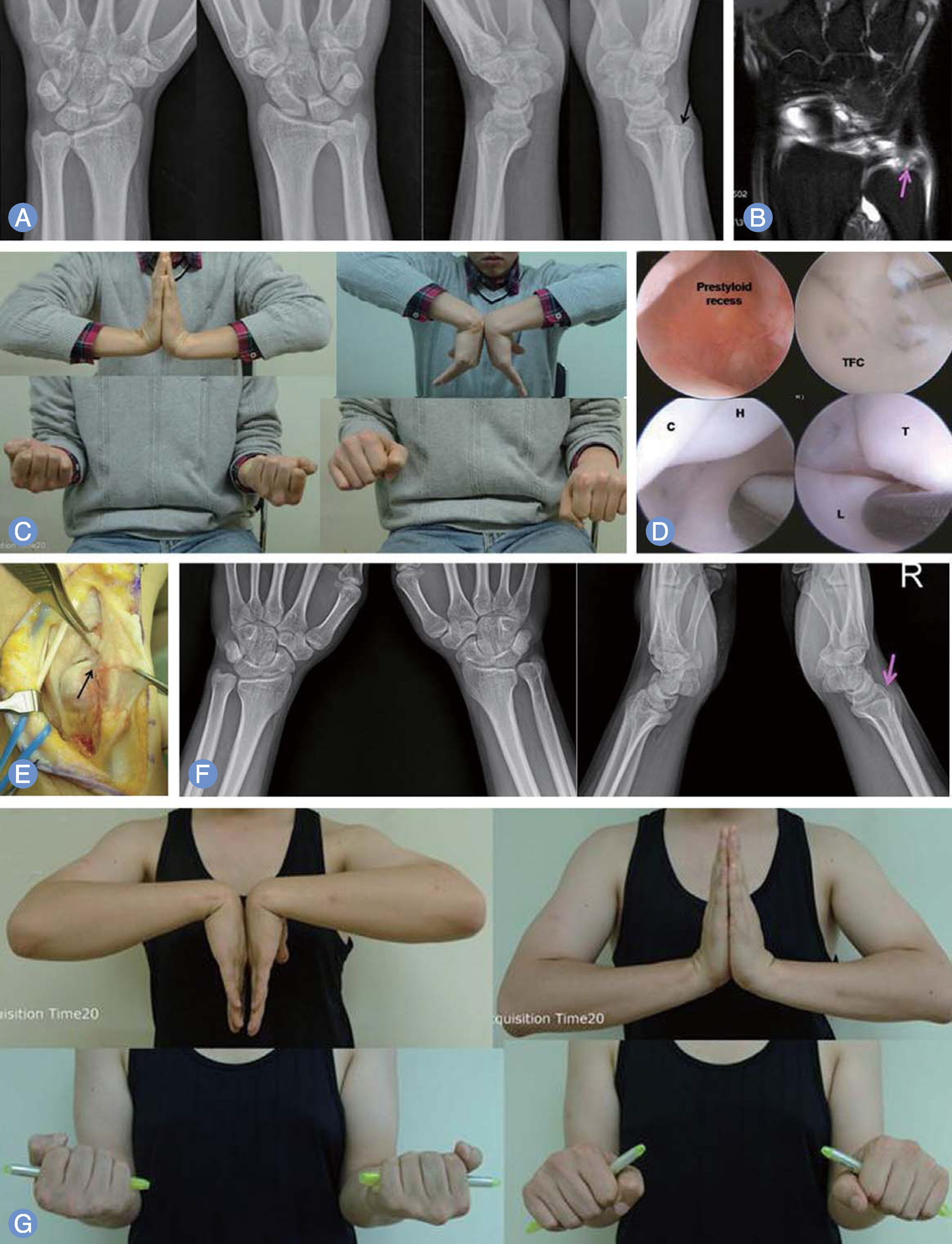J Korean Soc Surg Hand.
2014 Jun;19(2):87-94. 10.12790/jkssh.2014.19.2.87.
Open Repair of Triangular Fibrocartilage Complex Type 1B Tear
- Affiliations
-
- 1Upper Extremity and Microsurgery Center, Department of Orthopedic Surgery, Semyeong Christianty Hospital, Pohang, Korea. osdrrih@gmail.com
- KMID: 2097614
- DOI: http://doi.org/10.12790/jkssh.2014.19.2.87
Abstract
- Most common traumatic type 1B tear of triangular fibrocartilage complex (TFCC), according to the Palmer's classification, may lead to the loss of the stability of distal radioulnar joint and is known to be one cause of the persisted ular side wrist pain. Recently as the knowledge of the anatomical structures of the TFCC accumulates and the deep fiber of the distal radioulnar ligament is recognized to play a central role, an attempt to repair it to the original ulnar fovea insertion site has been done and reported successful results. Since the introduction of open technique, numerous arthroscopic technique has been developing. Here careful considerations ought to be given during open repair will be taken with review of the related articles.
Figure
Reference
-
References
1. Stuart PR, Berger RA, Linscheid RL, An KN. The dorsopalmar stability of the distal radioulnar joint. J Hand Surg Am. 2000; 25:689–99.
Article2. Gofton WT, Gordon KD, Dunning CE, Johnson JA, King GJ. Soft-tissue stabilizers of the distal radioulnar joint: an in vitro kinematic study. J Hand Surg Am. 2004; 29:423–31.
Article3. Palmer AK. Triangular fibrocartilage disorders: injury patterns and treatment. Arthroscopy. 1990; 6:125–32.
Article4. Hagert E, Hagert CG. Understanding stability of the distal radioulnar joint through an understanding of its anatomy. Hand Clin. 2010; 26:459–66.
Article5. Estrella EP, Hung LK, Ho PC, Tse WL. Arthroscopic repair of triangular fibrocartilage complex tears. Arthroscopy. 2007; 23:729–37. 37 e1.
Article6. Hermansdorfer JD, Kleinman WB. Management of chronic peripheral tears of the triangular fibrocartilage complex. J Hand Surg Am. 1991; 16:340–6.
Article7. Cooney WP, Linscheid RL, Dobyns JH. Triangular fibrocartilage tears. J Hand Surg Am. 1994; 19:143–54.
Article8. Nakamura T, Sato K, Okazaki M, Toyama Y, Ikegami H. Repair of foveal detachment of the triangular fibrocartilage complex: open and arthroscopic transosseous techniques. Hand Clin. 2011; 27:281–90.
Article9. Garcia-Elias M, Smith DE, Llusa M. Surgical approach to the triangular fibrocartilage complex. Tech Hand Up Extrem Surg. 2003; 7:134–40.
Article10. Pederzini LA, Tosi M, Prandini M, Botticella C. All-inside suture technique for Palmer class 1B triangular fibrocartilage repair. Arthroscopy. 2007; 23:1130.e1–4.
Article11. Atzei A. New trends in arthroscopic management of type 1-B TFCC injuries with DRUJ instability. J Hand Surg Eur Vol. 2009; 34:582–91.
Article12. Bain GI, McGuire D, Lee YC, Eng K, Zumstein M. Anatomic foveal reconstruction of the triangular fibrocartilage complex with a tendon graft. Tech Hand Up Extrem Surg. 2014; 18:92–7.
Article13. Adams BD, Divelbiss BJ. Reconstruction of the post-traumatic unstable distal radioulnar joint. Orthop Clin North Am. 2001; 32:353–63.
Article14. Moritomo H. Advantages of open repair of a foveal tear of the triangular fibrocartilage complex via a palmar surgical approach. Tech Hand Up Extrem Surg. 2009; 13:176–81.
Article15. Moritomo H, Masatomi T, Murase T, Miyake J, Okada K, Yoshikawa H. Open repair of foveal avulsion of the triangular fibrocartilage complex and comparison by types of injury mechanism. J Hand Surg Am. 2010; 35:1955–63.
Article16. Anderson ML, Larson AN, Moran SL, Cooney WP, Amrami KK, Berger RA. Clinical comparison of arthroscopic versus open repair of triangular fibrocartilage complex tears. J Hand Surg Am. 2008; 33:675–82.
Article
- Full Text Links
- Actions
-
Cited
- CITED
-
- Close
- Share
- Similar articles
-
- Surgical Technique for Repairing Foveal Tear of the Triangular Fibrocartilage Complex: Arthroscopic Knotless Repair
- Surgical Techniques for Repairing Foveal Tear of the Triangular Fibrocartilage Complex: Arthroscopic Transosseous Repair
- The Short Term Results of All-inside Arthroscopic Repair of the Triangular Fibrocartilage Complex Type 1B Tear by Knotless Suture Anchor
- Current Treatment of Triangular Fibrocartilage Complex Injuries
- Clinical Outcomes of Open Surgical Repair for Triangular Fibrocartilage Complex Foveal Detachment




